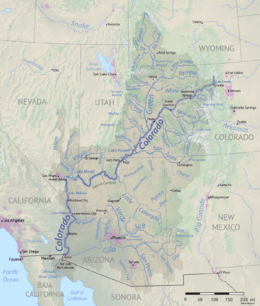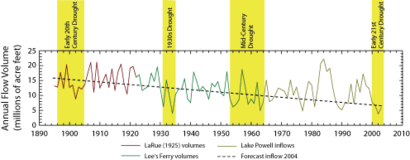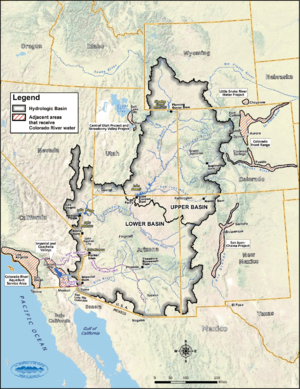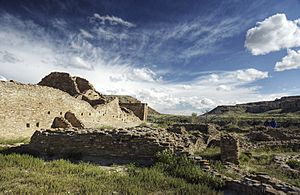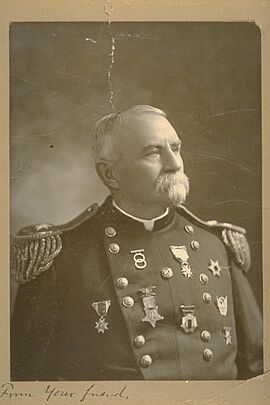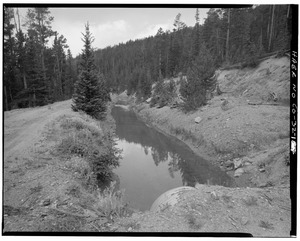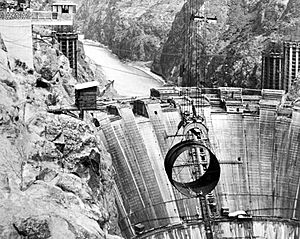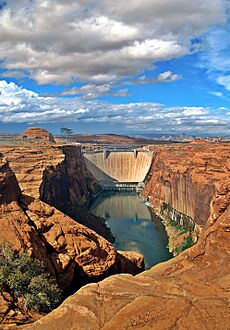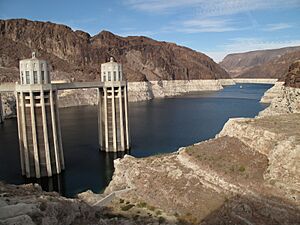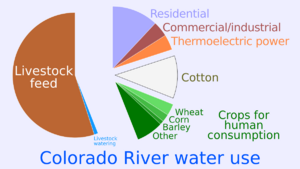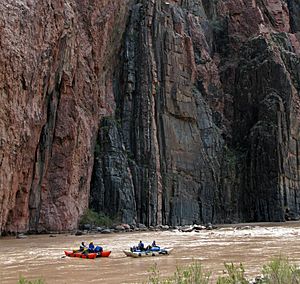Colorado River facts for kids
The Colorado River is one of the most important rivers in the Southwestern United States and northern Mexico. It is about 1,450 miles (2,330 km) long, making it the 5th longest river in the United States. The river flows through a huge, dry area called a watershed. This watershed covers parts of seven U.S. states and two Mexican states. The name "Colorado" comes from Spanish and means "colored reddish." This is because the river used to carry a lot of silt, which made its water look red.
The Colorado River starts in the Rocky Mountains of Colorado. It then flows southwest across the Colorado Plateau and through the famous Grand Canyon. After passing Lake Mead on the Arizona–Nevada border, it turns south towards Mexico. Once in Mexico, the river reaches the mostly dry Colorado River Delta at the top of the Gulf of California.
The Colorado River is famous for its amazing canyons, exciting whitewater rapids, and eleven U.S. National Parks. It provides water for about 40 million people. A large system of dams, reservoirs, and aqueducts takes almost all of its water. This water is used for farming and for cities. The river's strong flow and steep drop also help create hydroelectricity. This power helps meet energy needs in much of the western United States. Because so much water is used, the lower 100 miles (160 km) of the river has been mostly dry since the 1960s. It rarely reaches the sea anymore.
Native Americans have lived in the Colorado River basin for at least 8,000 years. Around 1 CE, large farming societies grew here. However, a mix of drought and poor farming practices caused them to disappear by the 1300s. Their descendants include tribes like the Puebloans. Other tribes, such as the Navajo, settled in the basin after the 1000s. In the 1500s, Spanish explorers began mapping and claiming the area. It became part of Mexico after Mexico won its independence from Spain in 1821. Even after most of the watershed became U.S. territory in 1846, much of the river was still unknown.
Several expeditions explored the Colorado in the mid-1800s. One famous trip, led by John Wesley Powell, was the first to go through the Grand Canyon's rapids. Many people started settling in the lower basin in the mid-to-late 1800s. Steamboats sailed from the Gulf of California to river landings, connecting to wagon roads. Starting in the 1860s, gold and silver discoveries brought miners to the upper Colorado River basin.
Major river management began in the early 1900s. Important rules were set in treaties called the "Law of the River." The U.S. government built most of the big dams and aqueducts between 1910 and 1970. The largest, Hoover Dam, was finished in 1935. Many water projects also involved state and local governments. Now, almost all the water is used up. The Colorado and the nearby Rio Grande are among the most controlled rivers in the world. Since 2000, a long drought has made water problems worse. The way humans use and control the river continues to cause debate.
Contents
- The Colorado River's Journey: Where Does it Flow?
- How Much Water Does the Colorado River Carry?
- The Colorado River's Drainage Basin: A Vast Landscape
- The River's Deep History: How the Grand Canyon Formed
- Human History Along the Colorado River
- Engineering and Development: Managing the River
- Ecology: Wildlife, Plants, and Environmental Impacts
- Recreation: Fun on the Colorado River
- Images for kids
- See also
The Colorado River's Journey: Where Does it Flow?

The Colorado River starts at La Poudre Pass in the Never Summer Mountains. This is in Rocky Mountain National Park, Colorado, about 10,184 ft (3,104 m) above sea level. After flowing south for a short distance, the river turns west below Grand Lake. This is the largest natural lake in Colorado. For its first 250 miles (400 km), the Colorado cuts through the mountainous Western Slope. This area is west of the Continental Divide, which separates rivers flowing to the Pacific from those flowing to the Atlantic.
As it flows southwest, the Colorado gets stronger from many smaller rivers joining it. These include the Blue, Eagle, and Roaring Fork rivers. After passing through De Beque Canyon, the Colorado leaves the Rockies and enters the Grand Valley. This is a big farming area where it meets the Gunnison River at Grand Junction. Most of the upper river is a fast, whitewater stream. It is usually 200 to 500 feet (60 to 150 m) wide and 6 to 30 feet (2 to 9 m) deep. In some places, like the marshy Kawuneeche Valley, it spreads out into many small channels.
From Grand Junction, the Colorado turns northwest. Then it cuts southwest across the Colorado Plateau. This is a huge desert area where the states of Arizona, Colorado, New Mexico, and Utah meet (the Four Corners). Here, the climate gets much drier than in the Rocky Mountains. The river starts to carve deeper and deeper canyons into the bare rock. This begins with Ruby Canyon and then Westwater Canyon as it enters Utah. Further downstream, it receives the Dolores River and forms the southern border of Arches National Park. It then passes Moab and flows through "The Portal." Here, it exits the Moab Valley between two 1,000-foot (300 m) sandstone cliffs.
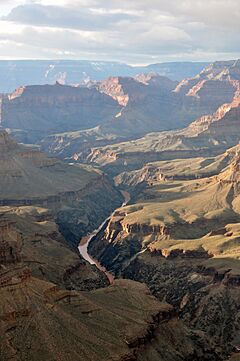
In Utah, the Colorado flows mostly through "slickrock" country. This area has narrow canyons and unique "folds" in the rock layers. It is one of the hardest-to-reach places in the United States. Below where the Green River joins it in Canyonlands National Park, the Colorado enters Cataract Canyon. This canyon is known for its dangerous rapids. Then it flows into Glen Canyon, famous for its arches and rock formations. Here, the San Juan River joins the Colorado from the east. The Colorado then enters northern Arizona. Since the 1960s, Glen Canyon Dam near Page has flooded Glen Canyon, creating Lake Powell for hydroelectricity.
In Arizona, the river passes Lee's Ferry. This was an important crossing for early explorers and settlers. Since the early 1900s, it has been the main place where Colorado River flows are measured. This helps decide how much water each state gets. Downstream, the river enters Marble Canyon, which is the start of the Grand Canyon. It passes under the Navajo Bridges and now flows south. Below where the Little Colorado River joins it, the river turns west into Granite Gorge. This is the most amazing part of the Grand Canyon. Here, the river cuts up to one mile (1.6 km) deep into the Colorado Plateau. It shows some of the oldest rocks on Earth, dating back 2 billion years. The 277 miles (446 km) of the river in the Grand Canyon are mostly inside Grand Canyon National Park. This section is known for its tough whitewater rapids, with deep pools up to 110 feet (34 m) deep between them.
At the end of the Grand Canyon, the Colorado widens into Lake Mead. This is the largest reservoir in the United States. It was formed by Hoover Dam on the border of Arizona and Nevada. The dam is near Las Vegas and helps manage the Colorado River. It controls floods and stores water for farms and cities. Below the dam, the river passes under the Mike O'Callaghan–Pat Tillman Memorial Bridge. This bridge is nearly 900 feet (270 m) above the water, making it the highest concrete arch bridge in the Western Hemisphere. Then the river turns south towards Mexico, forming the Arizona–Nevada and Arizona–California borders.

After leaving the Black Canyon, the river flows into the Lower Colorado River Valley (LCRV). This is a desert area that relies on farming and tourism. It is also home to several large Indian reservations. The river here is wide and moderately deep, usually 500 to 1,000 feet (150 to 300 m) wide and up to 0.25 miles (400 m) across. Depths range from 8 to 60 feet (2 to 20 m). Before the Colorado was controlled in the 1900s, the lower river often changed its path because of seasonal floods.
The LCRV is one of the most populated areas along the river. It has many towns like Bullhead City, Arizona, Needles, California, and Lake Havasu City, Arizona. Several large canals take water from the river here. This water is used for local needs and for distant areas like the Salt River Valley of Arizona and Southern California. The last major U.S. diversion is at Imperial Dam. Here, over 90 percent of the river's flow is sent into the Gila Gravity Canal and the much bigger All-American Canal. This water irrigates California's Imperial Valley, which is a very productive farming region in winter.
Below Imperial Dam, only a small amount of the Colorado River continues past Yuma, Arizona. It then meets the Gila River, which carries water from western New Mexico and most of Arizona. The Colorado then forms 24 miles (39 km) of the Mexico–United States border. At Morelos Dam, all the remaining water is diverted to irrigate the Mexicali Valley in Mexico. Below San Luis Río Colorado, the Colorado flows entirely into Mexico, forming the Baja California–Sonora border. Since 1960, the river between here and the Gulf of California has been dry or just a trickle. The Hardy River provides most of the water that flows into the Colorado River Delta. This is a large flat area covering about 3,000 square miles (7,800 km2) in northwestern Mexico. A big estuary forms here before the Colorado empties into the Gulf, about 75 miles (120 km) south of Yuma. Sometimes, the International Boundary and Water Commission allows a special "pulse flow" of water to help the delta.
Before the 1900s, when the lower Colorado was not controlled, a large tidal bore (a wave that travels up a river) was common in the delta. This wave, called El Burro, formed near Montague Island during spring tides and moved upstream.
Major Rivers Joining the Colorado
The Colorado River has more than 25 important rivers that flow into it. The Green River is the largest, both in length and how much water it carries. The Green River collects water from the Wind River Range in Wyoming, the Uinta Mountains in Utah, and the Rockies in northwestern Colorado. The Gila River is the second longest and drains a larger area than the Green. However, it carries much less water because its climate is drier and more water is taken for farming and cities. The Gunnison River and San Juan River, which get most of their water from melting snow in the Rocky Mountains, naturally add more water to the Colorado than the Gila River used to.
How Much Water Does the Colorado River Carry?
In its natural state, the Colorado River used to pour about 16.3 million acre-feet (20 km3) of water into the Gulf of California each year. This was an average flow of 22,500 cubic feet per second (640 m3/s). Its flow was not steady at all. Before big dams were built, the Colorado was a river of extremes. Summer floods often carried more than 100,000 cubic feet per second (2,800 m3/s) of water. In winter, flows could drop as low as 2,500 cubic feet per second (71 m3/s). At Topock, Arizona, a record high flow of 384,000 cubic feet per second (10,900 m3/s) was recorded in 1884. A record low of 422 cubic feet per second (11.9 m3/s) was recorded in 1935. Since the building of Hoover Dam, the lower Colorado rarely goes above 35,000 cubic feet per second (990 m3/s) or below 4,000 cubic feet per second (110 m3/s). The total amount of water each year also changes a lot. It ranged from a high of 22.2 million acre-feet (27.4 km3) in 1984 to a low of 3.8 million acre-feet (4.7 km3) in 2002. However, in most years, only a small amount of this water, if any, reaches the Gulf.
About 85–90 percent of the Colorado River's water comes from melting snowpack in the Rocky Mountains of Colorado and Wyoming. The three main rivers that feed the upper Colorado—the Gunnison, Green, and San Juan—alone deliver almost 9 million acre-feet (11 km3) of water each year. The remaining 10 to 15 percent comes from other sources, mainly groundwater and summer monsoon storms. Rivers in the Lower Basin often have sudden floods from monsoons, but these storms do not add a lot of water overall. The annual flow follows the snowmelt, which usually starts in April and peaks in May and June.
Because water is taken out, the flow at the mouth of the river has steadily dropped since the early 1900s. Since 1960, the Colorado has usually dried up before reaching the sea, except for a few wet years. Besides water use, flows have also dropped because of water evaporating from reservoirs and warmer temperatures reducing winter snow. Several of the Colorado's main rivers, like the Gila River, also no longer reach the Colorado because their water is used upstream.
The average flow rate of the Colorado River at the U.S.–Mexico border is 3,869 cubic feet per second (109.6 m3/s). This is about one-fifth of what the natural flow would be. Below this point, the remaining water is used to irrigate the Mexicali Valley. This leaves a dry riverbed from Morelos Dam to the sea, which only gets water from irrigation drainage. However, there have been exceptions, especially from 1983–1987. During these years, the Colorado reached the sea again after many years of record-breaking snowfall. In 1984, 16.5 million acre-feet (20.4 km3) of extra water reached the ocean.
The Colorado River's Drainage Basin: A Vast Landscape
The Colorado River Basin covers 246,000 square miles (640,000 km2). This makes it the seventh largest drainage basin in North America. About 97 percent of the basin is in the United States. It stretches into western Colorado and New Mexico, southwestern Wyoming, eastern and southern Utah, southeastern Nevada and California, and most of Arizona. The parts in Mexico are very small and do not add much water.
For managing water, the Colorado River Basin is split into the Upper Basin (the area above Lees Ferry) and the Lower Basin. The Upper Basin is only 45 percent of the land area. However, it provides 92 percent of the water that flows into the river.
The eastern edge of the Colorado River Basin follows the North American Continental Divide. This is mainly formed by the Rocky Mountains. The Wind River Range in Wyoming is the northern edge of the basin. Rivers near the east side of the divide flow into the Mississippi River and Rio Grande. Areas north of the Wind River Range flow into the Columbia River. The western edge of the basin is made of mountains and plateaus that border the Great Basin. These include the Uinta Mountains and Wasatch Range.
Much of the basin is at a high elevation. The average height is 5,500 feet (1,700 m). Lees Ferry, which is more than halfway along the Colorado River from its source, is 3,150 feet (960 m) above sea level. The highest point in the Colorado River Basin is 14,321-foot (4,365 m) Uncompahgre Peak in Colorado.

About 72 percent of the Colorado River Basin is dry. The Sonoran and Mojave deserts cover the southern part. The Colorado Plateau covers much of the central part. The Colorado Plateau has most of the big canyons made by the Colorado River and its branches. About 23 percent of the basin is forest, mostly in the Rocky Mountains. Other forests are on the Kaibab, Aquarius, and Markagunt plateaus in Utah and Arizona. These high plateaus are often over 9,000 feet (2,700 m) high. Developed land in the basin is mostly for farming that uses irrigation. This is mainly in the Grand Valley, the Lower Colorado River Valley, and the Salt River Valley. However, farms cover only 2–3 percent of the whole basin. Cities cover less than 1 percent.
The climate in the Colorado River Basin changes a lot. It ranges from hot desert in the south to alpine in the Rocky Mountains. Average high temperatures are 25.3 °C (77.5 °F) in the Upper Basin and 33.4 °C (92.1 °F) in the Lower Basin. Lows average −3.6 and 8.9 °C (25.5 and 48.0 °F). Annual rainfall averages 6.5 inches (164 mm). It ranges from over 60 inches (1,500 mm) in some parts of the Rockies to less than 4 inches (100 mm) in dry desert valleys. The Upper Basin usually gets snow and rain in winter and early spring. The Lower Basin gets most of its rain from strong but rare summer thunderstorms, called the North American Monsoon.
As of 2010, about 13 million people lived within the Colorado River basin. However, about 40 million people live in areas that get water from the Colorado River. States in the Colorado River basin are growing very fast. The population of Nevada grew by about 66 percent between 1990 and 2000. Arizona grew by about 40 percent. Phoenix, Arizona, Las Vegas, Nevada, and Mexicali, Baja California are the largest cities in the basin. Other important cities include Tucson, Arizona, St. George, Utah, and Flagstaff, Arizona. Because the river flows through rough and difficult land, there are only a few big towns right along the Colorado River itself. These include Grand Junction, Colorado and Yuma, Arizona.
The River's Deep History: How the Grand Canyon Formed
About 100 million years ago, much of western North America was still part of the Pacific Ocean. Strong forces from Earth's plates pushing together created the Rocky Mountains between 50 and 75 million years ago. This event is called the Laramide orogeny. The Colorado River first formed as a stream flowing west from the mountains. The mountain building also changed the Green River's path, making it flow west towards the Colorado. About 30 to 20 million years ago, volcanoes erupted. This created smaller mountains and spread huge amounts of ash and rock over the area. The Colorado Plateau began to rise about 55 to 34 million years ago. But it reached its current height about 5 million years ago, which is when the Colorado River started flowing into the Gulf of California.
Scientists are not sure exactly when and how the river's current path and the Grand Canyon were formed. Before the Gulf of California formed about 12 to 5 million years ago, the Colorado flowed west to the Pacific Ocean. It might have even helped form the Monterey submarine canyon. As the Colorado Plateau kept rising between 5 and 2.5 million years ago, the river kept its old path. It then began to cut the Grand Canyon.

Sediments carried by the Colorado River from the plateau created a huge delta. This delta, made of over 10,000 cubic miles (42,000 km3) of material, blocked off the northern part of the gulf in about 1 million years. Cut off from the ocean, the part of the gulf north of the delta eventually dried up. This formed the Salton Sink, which was about 260 feet (79 m) below sea level. Since then, the river has flowed into the Salton Sink at least three times. This turned it into Lake Cahuilla, which at its largest flooded the valley up to modern-day Indio, California. The lake took about 50 years to evaporate after the Colorado started flowing to the Gulf again. Today's Salton Sea is a much smaller version of Lake Cahuilla.
Between 1.8 million and 10,000 years ago, huge flows of basalt (volcanic rock) from the Uinkaret volcanic field in northern Arizona blocked the Colorado River inside the Grand Canyon. At least 13 lava dams were formed. The largest was over 2,300 feet (700 m) high, backing up the river for nearly 500 miles (800 km) to modern-day Moab, Utah. These dams likely did not last long, perhaps only a few decades, before breaking or washing away. When the lava dams failed, they caused huge floods. These floods might have been some of the largest ever in North America. Flood deposits show that waves as high as 700 feet (210 m) passed through the Grand Canyon.
Human History Along the Colorado River
Native American Peoples and Their Lives
The first people in the Colorado River basin were likely Paleo-Indians. They arrived on the Colorado Plateau about 12,000 years ago. Not much human activity happened until the Desert Archaic Culture appeared. From 8,000 to 2,000 years ago, these people made up most of the region's population. They were mostly nomadic, gathering plants and hunting small animals. Another early group was the Fremont culture, who lived on the Colorado Plateau from 2,000 to 700 years ago. The Fremont were probably the first to farm and build stone houses. They also left behind many rock carvings and paintings.
Starting in the early centuries A.D., people in the Colorado River basin began to form large farming societies. Some of these lasted hundreds of years and grew into well-organized civilizations. The Ancient Puebloan people of the Four Corners region were descendants of the Desert Archaic culture. The Puebloan people built a complex system to provide drinking and irrigation water in Chaco Canyon in New Mexico.
The Puebloans controlled the San Juan River basin. Their main center was in Chaco Canyon. There, they built over 150 multi-story pueblos, or "great houses." The largest, Pueblo Bonito, had more than 600 rooms. The Hohokam culture lived along the middle Gila River starting around 1 A.D. Between 600 and 700 A.D., they began to use irrigation on a large scale. They built a huge system of irrigation canals on the Gila and Salt rivers. This system was hundreds of miles long and could water a vast amount of farmland. Both civilizations had large populations. The Chaco Canyon Puebloans had between 6,000 and 15,000 people. Estimates for the Hohokam range from 30,000 to 200,000.
Drought and Changes
These settled peoples used a lot of resources from their environment, including logging. Building irrigation canals might have changed how many rivers in the Colorado River basin looked. Before humans, rivers like the Gila and Salt were shallow streams with low banks and large floodplains. Over time, floods caused the irrigation canals to cut deeper. This led to the original streams also cutting deeper into arroyos, making farming hard. People tried different ways to fix these problems, like building large dams. But when a huge drought hit the region in the 1300s A.D., these ancient civilizations suddenly disappeared. Some Puebloans moved to the Rio Grande Valley. They became the ancestors of the Hopi, Zuni, Laguna, and Acoma people in western New Mexico. Many of the tribes living in the Colorado River basin when Europeans arrived were descendants of Puebloan and Hohokam survivors. Others had lived there for a long time or moved in from nearby lands.
The Navajo were an Athabaskan people who moved from the north into the Colorado River basin around 1025 A.D. They quickly became the most powerful Native American tribe in the basin. Their land stretched over parts of Arizona, New Mexico, Utah, and Colorado. The Navajo learned farming skills from the Puebloans before the Pueblo civilization ended. Many other tribes have lived along the Colorado River for a long time. The Mohave have lived along the rich lands of the lower Colorado since 1200 A.D. They were fishermen and farmers, using the river's yearly floods to water their crops. Ute peoples have lived in the northern Colorado River basin for at least 2,000 years. The Apache, Cocopah, Havasupai, Hualapai, and many other groups also lived along the Colorado River and its branches.
European Arrival and Its Effects
Starting in the 1600s, contact with Europeans brought big changes to Native Americans in the Colorado River basin. Missionaries tried to convert indigenous peoples to Christianity. The Spanish brought sheep and goats to the Navajo, who began to rely on them for food and wool. By the mid-1500s, the Utes got horses from the Spanish and introduced them to the Colorado River basin. Horses spread through trade among tribes. They made hunting, communication, travel, and warfare much easier for Native Americans.

More and more European and American explorers and settlers came to the region. This eventually led to conflicts that forced many Native Americans off their traditional lands. After the U.S. took the Colorado River basin from Mexico in the Mexican–American War in 1846, U.S. military forces led by Kit Carson forced over 8,000 Navajo people from their homes. This event is known as the Long Walk of the Navajo. Many died along the way. Four years later, the Navajo signed a treaty that moved them to a reservation in the Four Corners region. This is now called the Navajo Nation, the largest Native American reservation in the U.S.
The Mohave were also forced from their land after small fights and raids in the late 1850s. In 1870, the Mohave were moved to a reservation at Fort Mojave. Some Mohave were also moved to the Colorado River Indian Reservation on the Arizona–California border. In the 1940s, some Hopi and Navajo people were also moved there. These four tribes now form the Colorado River Indian Tribes.
The water rights of Native Americans in the Colorado River basin were mostly ignored when the river's water resources were developed in the 1800s and 1900s. Building dams often hurt tribal peoples. For example, the Chemehuevi's riverside lands were flooded after Parker Dam was finished in 1938. Ten Native American tribes in the basin now have or claim water rights to the Colorado River. The U.S. government has taken some steps to help develop water resources for Native American reservations. The first federally funded irrigation project in the U.S. was an irrigation canal on the Colorado River Indian Reservation in 1867. The Navajo continue to seek more water rights because of water supply problems on their reservation. About 40 percent of its people have to truck water many miles to their homes. In the 2000s, they have filed legal claims against Arizona, New Mexico, and Utah for more water rights. Some of these claims have been successful.
Early Explorers of the Colorado River
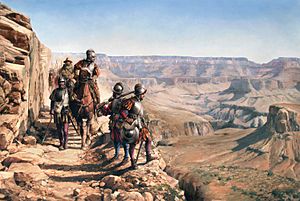
In the 1500s, the Spanish began to explore and settle western North America. They were looking for the Seven Cities of Gold, or "Cibola," which were rumored to be built by Native Americans in the desert Southwest. It is likely that Francisco de Ulloa was the first European to see the Colorado River in 1536. He sailed to the top of the Gulf of California. Francisco Vásquez de Coronado's expedition in 1540–1542 started as a search for these cities. But after hearing about a large river to the west, he sent García López de Cárdenas to find it. With help from Hopi Indians, Cárdenas and his men were the first outsiders to see the Grand Canyon. Cárdenas was reportedly not impressed with the canyon. He thought the Colorado River was only 6 feet (1.8 m) wide and that 300-foot (91 m)-tall rock formations were the size of a man. They tried to go down to the river but failed because of the difficult land and hot weather.
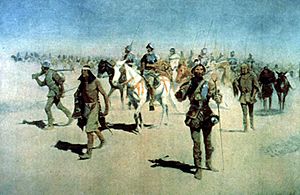
In 1540, Hernando de Alarcón reached the river's mouth. He planned to bring supplies to Coronado's expedition. Alarcón might have sailed the Colorado as far upstream as the present-day California–Arizona border. Coronado never reached the Gulf of California, and Alarcón eventually left. Melchior Díaz reached the delta in the same year. He wanted to meet Alarcón, but Alarcón was already gone. Díaz named the Colorado River Rio del Tizon ("Firebrand River"). He saw local natives using firebrands to warm themselves. The name Tizon was used for the next 200 years. The name Rio Colorado ("Red River") was first used by Father Eusebio Francisco Kino in his maps and reports from 1700–1702. He discovered that California was a peninsula, not an island. Kino's 1701 map is the first known map to call the river the Colorado.
In the 1700s and early 1800s, many Americans and Spanish believed in the Buenaventura River. They thought it ran from the Rocky Mountains in Utah or Colorado to the Pacific Ocean. The name Buenaventura was given to the Green River by Silvestre Vélez de Escalante in 1776. But Escalante did not know that the Green River flowed into the Colorado. Many later maps showed the Green and Colorado rivers connecting with other rivers and lakes before flowing west through the Sierra Nevada into California. Mountain man Jedediah Smith reached the lower Colorado in 1826. He correctly believed it was a continuation of the Green River. John C. Frémont's expedition in 1843 proved that no river crossed the Great Basin and Sierra Nevada. This officially showed that the Buenaventura myth was false.
Between 1850 and 1854, the U.S. Army explored the lower Colorado River from the Gulf of California. They wanted to find a cheaper way to supply Fort Yuma. They used a schooner and a longboat. Lieutenant George Derby suggested using a shallow steamboat to carry supplies upriver.
Later, contractors brought barges to supply the fort. One barge sank. The second one finally reached Fort Yuma, but it took a long time. This showed that steamboats were a better idea. In November 1852, the Uncle Sam, a 65-foot-long paddle steamer, became the first steamboat on the Colorado River. It was built and launched near the river's mouth. It could carry 35 tons of supplies and took 15 days for the first 120-mile trip. It made many trips, cutting the travel time to 12 days. The Uncle Sam later sank in a flood. But it proved that steamboats were useful for supplying Fort Yuma.
George Alonzo Johnson and his partners then got a new contract. They brought parts for a more powerful steamboat, the General Jesup, from San Francisco. It was put together at the river's mouth and reached Fort Yuma on January 18, 1854. This new boat was very successful. It could carry 50 tons of cargo and made round trips in only four or five days. This cut costs a lot.

Lorenzo Sitgreaves led the first U.S. Army mission across northern Arizona to the Colorado River in 1851. The second expedition was part of the Pacific Railroad Survey in 1853–1854, led by Lt. Amiel Weeks Whipple.
George A. Johnson helped get money from Congress for a military expedition up the river. He wanted to provide the boats, but the expedition leader, Lt. Joseph Christmas Ives, refused his offer. Before Ives could finish putting his steamboat together, George A. Johnson started his own exploration from Fort Yuma on December 31, 1857. He went up the river in his steamboat, the General Jesup, for 21 days. He reached the first rapids in Pyramid Canyon, over 300 miles (480 km) above Fort Yuma. He turned back because he was running low on food. On his way back, he met Lieutenant Ives, who was exploring if the Colorado River could be used for navigation. Ives and his men used a special steamboat, the U.S.S. Explorer. They traveled up the river as far as Black Canyon. Ives then took a small boat further up. After many problems with shallow water, Ives said that the Colorado River would "be forever unvisited and undisturbed."
Until 1866, El Dorado Canyon was the furthest point boats could go on the Colorado River. In that year, Captain Robert T. Rogers reached Callville, Nevada, on October 8, 1866. Callville remained the furthest point until July 7, 1879. On that day, Captain J. A. Mellon reached the mouth of the Virgin River at Rioville. From 1879 to 1887, Rioville, Nevada, was the highest point steamboats could reach during high water.
Powell's Famous Expeditions (1869–1871)
Until the mid-1800s, long parts of the Colorado and Green rivers were mostly unexplored. This was because they were far away and dangerous to travel. People heard rumors of huge waterfalls and violent rapids. In 1869, John Wesley Powell, a Civil War veteran with one arm, led an expedition. He aimed to travel both rivers all the way down to St. Thomas, Nevada. Powell and nine men, none of whom had experience with whitewater, started in May. After going through the rapids of the Gates of Lodore, Cataract Canyon, and other gorges, they reached the mouth of the Little Colorado River. Powell wrote some famous words about the Grand Canyon there:
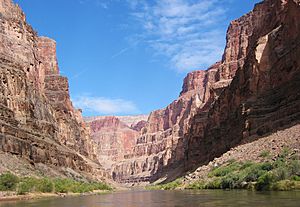
"We are now ready to start on our way down the Great Unknown. Our boats, tied to a common stake, are chafing each other, as they are tossed by the fretful river. They ride high and buoyant, for their loads are lighter than we could desire. We have but a month's rations remaining. The flour has been re-sifted through the mosquito net sieve; the spoiled bacon has been dried, and the worst of it boiled; the few pounds of dried apples have been spread in the sun, and re-shrunken to their normal bulk; the sugar has all melted, and gone on its way down the river; but we have a large sack of coffee. The lighting of the boats has this advantage: they will ride the waves better, and we shall have little to carry when we make a portage.
We are three-quarters of a mile in the depths of the earth, and the great river shrinks into insignificance, as it dashes its angry waves against the walls and cliffs, that rise to the world above; they are but puny ripples, and we but pigmies, running up and down the sands, or lost among the boulders.
We have an unknown distance yet to run; an unknown river yet to explore. What falls there are, we know not; what rocks beset the channel, we know not; what walls rise over the river, we know not; Ah, well! we may conjecture many things. The men talk as cheerfully as ever; jests are bandied about freely this morning; but to me the cheer is somber and the jests are ghastly."
Powell led a second expedition in 1871, this time with money from the U.S. government. The explorers named many places along the Colorado and Green rivers, like Glen Canyon and Flaming Gorge. Today's Lake Powell, which covers Glen Canyon, is also named after him.
American Settlement and Development
Starting in the late 1800s, the lower Colorado River became important for steamboat trade. In 1852, the Uncle Sam was launched to bring supplies to Fort Yuma. Even though this boat sank, more commercial boats quickly appeared. River transport was much cheaper than moving goods over land. Traveling on the Colorado River was dangerous because the channel was shallow and the water levels changed. The first steamboat on the river, the Colorado of 1855, was designed to carry 60 short tons (54 t) while needing less than 2 feet (0.6 m) of water. The tidal bore (a large wave) of the lower Colorado was also a big danger. In 1922, a 15-foot (4.6 m)-high wave sank a ship going to Yuma, killing many people. Steamboats quickly became the main way to communicate and trade along the river. But then railroads started competing in the 1870s. Finally, dams built along the lower river after 1909 stopped ships from passing, as they had no locks.
During the mid-1800s, American pioneers settled many western states. But they generally avoided the Colorado River basin until the 1850s. Under Brigham Young's plan for a "vast empire in the desert," Mormon settlers were among the first white people to live permanently in the area. They settled along the Santa Clara River in the winter of 1855–1856. In the lower Colorado, mining was the main reason for economic growth. This included copper mining in New Mexico Territory in the 1850s, then a gold rush on the Gila River in 1859, and the Colorado River Gold Rush in 1862.
In 1860, Mormons started settlements to grow cotton along the Virgin River in Utah. From 1863 to 1865, Mormon colonists founded St. Thomas and other colonies in Nevada. Stone's Ferry was set up on the Colorado River to carry their farm products to mining areas. Also, in 1866, a steamboat landing was made at Callville. This was meant to be a way for Mormon settlements to reach the Pacific Ocean. These settlements reached about 600 people before being left in 1871. For almost ten years, these valleys became a safe place for outlaws. One Mormon settler, Daniel Bonelli, stayed and ran the ferry. He started mining salt nearby and brought it downriver in barges.
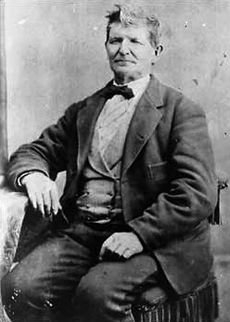
Mormons founded settlements in the Duchesne River Valley in the 1870s. They later settled the Little Colorado River valley. They also started settlements along the Gila River in central Arizona in 1871. These early settlers were amazed by the ruins of the Hohokam civilization that had lived there before. The Mormons were the first white people to develop the basin's water resources on a large scale. They built complex systems of dams and canals to water their crops. They also had many sheep and cattle ranches.
One main reason Mormons could settle Arizona was Jacob Hamblin's ferry across the Colorado at Lee's Ferry. This ferry started in March 1864. This spot was the only place for hundreds of miles where the canyon walls were low enough for a transport route. John Doyle Lee set up a more permanent ferry system there in 1870. Lee chose to run the ferry to escape from Mormon leaders who blamed him for the Mountain Meadows massacre. In this event, 120 travelers were killed by a local militia disguised as Native Americans. Even though it was on a major travel route, Lee's Ferry was very isolated. In 1928, the ferry sank, killing three men. Later that year, the Navajo Bridge was finished 5 miles (8 km) downstream, making the ferry no longer needed.
Gold discoveries from the mid-1800s to early 1900s brought many settlers to the upper Colorado River basin. In 1859, adventurers found gold along the Blue River in Colorado. They started the mining town of Breckenridge. In 1875, even bigger discoveries were made along the Uncompahgre and San Miguel rivers. This led to the creation of Ouray and Telluride. Because most gold in the upper Colorado River came from lode deposits (veins in rock), large mining systems and heavy machines were needed to get it out. Mining is still a big part of the economy in the upper basin. It has also caused acid mine drainage problems in some streams and rivers.
The Colorado River region in Mexico became a popular place for Americans to invest in farming in the late 1800s. Mexico's President Porfirio Díaz welcomed foreign money to develop the country. The Colorado River Land Company, formed by Los Angeles Times publisher Harry Chandler and others, developed the Mexicali Valley in Baja California into a successful farming area. The company used Colorado River water to irrigate the rich soil. The company mostly avoided the chaos of the Mexican Revolution (1910–20). But after the revolution, the Mexican government took the company's land to meet the demand for land reform.
The Name of the Upper Colorado River
The Colorado River did not officially flow through the State of Colorado until July 25, 1921. Before that date, the Colorado River officially started where the Grand and Green rivers met in what is now Canyonlands National Park in Utah. The Grand River was also known by other names before the 1870s.
In 1921, U.S. Representative Edward T. Taylor from Colorado asked Congress to rename the Grand River as the Colorado River. On July 25, 1921, President Warren G. Harding signed a resolution to change the name. This happened despite objections from Wyoming, Utah, and the United States Geological Survey. They pointed out that the Green River was longer and had a larger drainage basin.
Engineering and Development: Managing the River
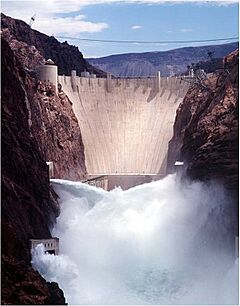
About 40 million people rely on the Colorado River's water for farming, industry, and homes. The Colorado irrigates 5.5 million acres (2.2 million hectares) of farmland. Its hydroelectric plants produce 12 billion kilowatt hours (KWh) of electricity each year. This electricity is key for providing power during peak demand times in the Southwest. The Colorado is so carefully managed that each drop of its water is used about 17 times in a single year. The Southern Nevada Water Authority has called the Colorado River one of the "most controlled, controversial and litigated rivers in the world."
In 1922, six U.S. states signed the Colorado River Compact. This agreement divided half of the river's flow to the Upper Basin (Colorado, New Mexico, Utah, Wyoming, and a small part of Arizona) and the other half to the Lower Basin (Arizona, California, Nevada, and parts of New Mexico and Utah). Each basin was given 7.5 million acre-feet (9.3 km3) of water per year. This amount was thought to be half of the river's yearly flow at Lee's Ferry. The plan assumed that about 17.5 million acre-feet of water flowed through the river each year.
Arizona first refused to sign the compact. It worried that California would take too much water from the lower basin. In 1944, they reached a deal. Arizona was given 2.8 million acre-feet (3.5 km3), but California's 4.4-million-acre-foot (5.4 km3) water was prioritized during droughts. These and other agreements made between 1922 and 1973 are now known as the Law of the River.
In 1944, a treaty between the U.S. and Mexico gave 1.5 million acre-feet (1.9 km3) of Colorado River water to Mexico each year. Morelos Dam was built in 1950 to help Mexico use its share.
Water Diversions Across Mountains
Large-scale development of Colorado River water began in the late 1800s. The Grand Ditch, which moves water from the river's source across the Continental Divide to dry eastern Colorado, was an amazing engineering feat when finished in 1890. This was the first of 24 "transmountain diversions." These projects move water across the Rocky Mountains as the population in the Front Range corridor grew. These diversions take water from the upper Colorado and its branches into other river basins. Today, about 80 percent of Colorado's population lives on the Eastern Slope of the Rockies, but 80 percent of the rain and snow falls on the Western Slope.
The Colorado-Big Thompson Project (C-BT) was planned at the same time as the Grand Ditch, but construction didn't start until the 1930s. Today, the C-BT is the largest of these diversions. It delivers 230,000 acre-feet (280,000,000 m3) of water per year from the Colorado River to cities north of Denver. Many other projects followed. The largest include the Roberts Tunnel, which brings water from the Blue River to Denver. The Fryingpan–Arkansas Project diverts water from the Fryingpan River to the Arkansas River basin.
Together, these diversions take about 580,000 acre-feet (720,000,000 m3) of water per year out of the Colorado River basin. Historically, most of this water was used for farming. But now, more water is used for cities and for recreation like snowmaking and improving streamflows for boating. Denver Water gets about 50 percent of its water from the Colorado River basin. However, these diversions have harmed the upper Colorado River system by reducing water flows in many smaller rivers. Several reservoirs have been built to help balance this by storing water for release during dry seasons.
The Imperial Valley and the Salton Sea
In 1900, the California Development Company (CDC) planned to irrigate the Imperial Valley. This was a dry area on the California–Mexico border. Water from the Colorado River could flow there by gravity because the valley was below sea level. Engineer George Chaffey designed the Alamo Canal. It split from the Colorado near Pilot Knob, California, and ran south into Mexico. There, it joined the Alamo River, a dry riverbed that used to carry floodwaters from the Colorado into the Salton Sink at the bottom of Imperial Valley. The plan worked at first. By 1903, about four thousand people lived in the valley, and over 100,000 acres (40,000 ha) of farmland was developed.
The Alamo Canal had constant problems because of the Colorado's high sediment and changing water levels. In early 1905, a flood destroyed the intake gates. Water began to flow out of control down the canal towards the Salton Sink. By August, the break was so big that it took the entire flow of the river, which began to flood the valley. The Southern Pacific Railroad tried to block the flow to protect their tracks. It took seven tries, over $3 million, and two years for the railroad, the CDC, and the government to permanently block the break. But not before part of the Imperial Valley was flooded under a 45-mile-long (72 km) lake, which is today's Salton Sea. This event showed that more development in the region would need a dam to control the Colorado's unpredictable flows.
Building Hoover Dam and Other Projects
A large dam on the Colorado River had been planned since the 1920s. In 1928, Congress allowed the Reclamation Service (now the U.S. Bureau of Reclamation, or USBR) to build the Boulder Canyon Project. Its main feature would be a dam on the Colorado in Black Canyon, 30 miles (48 km) southeast of Las Vegas, Nevada. On September 30, 1935, Hoover Dam was finished. It created Lake Mead, which can hold more than two years of the Colorado's flow. Lake Mead was, and still is, the largest artificial lake in the U.S. by storage capacity. Hoover Dam helped stabilize the lower Colorado River, stored water for farming during droughts, captured sediment, and controlled floods. Hoover was the tallest dam in the world when it was built and had the world's largest hydroelectric power plant.
The Boulder Canyon Project Act also approved the All-American Canal. This canal was built as a permanent replacement for the Alamo Canal. It stays entirely within the U.S. on its way to the Imperial Valley. The canal's intake is at Imperial Dam, 20 miles (32 km) above Yuma, Arizona. It diverts most of the Colorado's flow, with only a small part continuing to Mexico. With a capacity of over 26,000 cubic feet per second (740 m3/s), the All-American Canal is the largest irrigation canal in the world. Because of the hot, sunny climate, the Imperial Valley can grow crops all year. It has become one of the most productive farming regions in North America. The Coachella Canal, which branches off the All-American Canal, irrigates more land in the Coachella Valley.
Parker Dam was first built to divert water for the Colorado River Aqueduct. This aqueduct was planned by the Metropolitan Water District of Southern California to supply water to Los Angeles. Arizona opposed the dam, fearing California would take too much water. At one point, Arizona sent its National Guard to stop work on the dam. Eventually, they reached a compromise. Arizona dropped its objections in exchange for the USBR building the Gila Project, which irrigates land on the Arizona side of the river. By 1941, the 241-mile (388 km)-long Colorado River Aqueduct was finished. It delivered 1.2 million acre-feet (1.5 km3) of water to Southern California. This aqueduct allowed Los Angeles and its suburbs to keep growing. It provides water to about 10 million people today. The San Diego Aqueduct, which branches off the Colorado River Aqueduct, opened in stages between 1954–1971. It provides water to another 3 million people in the San Diego area.
The Las Vegas Valley in Nevada grew quickly after Hoover Dam. By 1937, Las Vegas had a pipeline to Lake Mead. Nevada officials thought there was enough groundwater for future growth. They were more interested in getting a lot of power from the dam than water. So they agreed to the smallest water share of all the states in the Colorado River Compact. In 2018, because Lake Mead's water levels were dropping, a second pipeline was built with a lower intake.
Colorado River Storage Project
In the first half of the 1900s, the Upper Basin states had used very little of their water from the Colorado River Compact. But by the 1950s, water demand was growing fast in Utah and New Mexico. These states started looking for ways to divert water from the Colorado Basin. The Upper Basin states worried they wouldn't be able to use all their water if the Lower Basin's demands kept growing. The Compact requires the Upper Basin to deliver at least 7.5 million acre-feet (9.3×109 m3) of water past Lee's Ferry each year. Without more reservoirs, the Upper Basin states couldn't use their full water amounts without affecting water deliveries to the Lower Basin in dry years.
In 1956, Congress allowed the USBR to build the Colorado River Storage Project (CRSP). This project planned several large reservoirs on the upper Colorado, Green, Gunnison, and San Juan Rivers. The first plans for the CRSP included two dams on the Green River inside Echo Park Canyon. This was criticized by the National Park Service and environmental groups. The debate got a lot of media attention. The USBR dropped its plans for the Echo Park dams. Instead, they made a proposed dam at Glen Canyon larger.
The controversy about Glen Canyon Dam didn't get big until construction was already well underway. Because Glen Canyon was in a remote area, most Americans didn't even know it existed. Those who did argued that it was more beautiful than Echo Park. The environmental movement in the American Southwest has opposed damming the Colorado River system. They say it harms the river's ecology and natural beauty. During the building of Glen Canyon Dam (1956–66), environmental groups promised to stop any more river development. Many later dam and aqueduct plans were stopped by public opposition. Sierra Club leader David Brower fought the dam for many years. He believed he was personally responsible for failing to prevent Glen Canyon's flooding.
Besides Glen Canyon Dam, the CRSP includes the Flaming Gorge Dam on the Green River. It also has the Blue Mesa, Morrow Point, and Crystal Dams on the Gunnison River. And it includes the Navajo Dam on the San Juan River. A total of 22 "participating projects" were later approved. These were built to develop local water supplies in different places across the Upper Basin states. These include the Central Utah Project, which delivers water from the Green River basin to Utah. The San Juan–Chama Project diverts water from the San Juan River to the Rio Grande Valley. Both are multi-purpose projects that serve farming, cities, and industries.
Water Supply After 2000: Challenges and Solutions
When the Colorado River Compact was written in the 1920s, it was based on only 30 years of river flow records. These records suggested an average yearly flow of 17.5 million acre-feet (21.6 km3) past Lee's Ferry. But modern studies of tree rings show that those three decades were probably the wettest in the past 500 to 1,200 years. The natural long-term annual flow past Lee's Ferry is likely closer to 13.5 million acre-feet (16.7 km3). This means more water was promised to river users than actually exists in the Colorado. Droughts have made this problem worse.
The most severe drought on record began in the early 2000s. The river basin has had above-average water flow in only five years between 2000 and 2021. The region is getting warmer. This means snow melts earlier, there is less rain, and more water evaporates. A 2004 study showed that even a small decrease in rain could lead to a big drop in river flow by 2050.
Since 2000, reservoir levels have changed a lot each year, but they have steadily gone down over time. The very dry period between 2000 and 2004 caused Lake Powell to drop to only one-third of its capacity in 2005. This was the lowest level since it was first filled in 1969. In late 2010, Lake Mead was close to a "drought trigger" level. If it reached this level, water supplies to Arizona and Nevada would be cut according to the Colorado River Compact. Because Arizona and Nevada have "junior" water rights compared to California, their water amounts can be cut to zero before California's.
A wet winter in 2011 temporarily raised lake levels. But dry conditions returned in the next two years. In 2014, the Bureau of Reclamation cut water releases from Lake Powell by 10 percent. This was the first such cut since the 1960s. This caused Lake Mead to drop to its lowest recorded level since 1937.
Water year 2018 had much less snow than average. In July 2021, after two more very dry winters, Lake Powell fell below its previous low from 2005. In response, the Bureau of Reclamation started releasing water from upstream reservoirs. This was to keep Powell above the minimum level needed to generate hydropower. Lake Mead fell below the 1,075-foot (328 m) level. This was expected to trigger federal cuts to Arizona and Nevada's water supplies for the first time ever. It was expected to keep dropping into 2022.
On August 16, 2021, the Bureau of Reclamation announced a shortage for the first time. They said that because of "ongoing historic drought and low runoff conditions," water releases from Glen Canyon Dam and Hoover Dam would be reduced in 2022. The Lower Basin reductions would cut Arizona's water by 18 percent, Nevada's by 7 percent, and Mexico's by 5 percent.
On June 14, 2022, Bureau of Reclamation Commissioner Camille Touton said that more cuts of 2-4 million acre-feet were needed to stabilize reservoir levels in 2023. Touton warned that if states could not agree on the cuts, the Interior department might use its legal power to reduce releases. When the states could not agree, Reclamation began steps to unilaterally reduce releases from Hoover and Glen Canyon Dams in 2023. As of December 2022, Nevada, Arizona, and California had not agreed on how to cut water use by about 30 percent. This amount was needed to keep levels in Lakes Mead and Powell from dropping too low. The Bureau of Reclamation predicted that water levels at Lake Powell could fall so low that by July 2023, Glen Canyon Dam would no longer be able to generate any hydropower.
In May 2023, the states finally reached a temporary agreement. This agreement aims to prevent the lakes from reaching "deadpool" (where water is too low to flow out). It reduces water amounts by 3 million acre-feet over three years (until the end of 2026). The cuts were less than the federal government had asked for. So, more cuts will be needed after 2026. Fewer cuts were needed in the short term because the Colorado River Basin had unusually rainy and snowy weather in early 2023.
The agreement was also easier to reach because many cuts are being paid for by one-time federal money. Billions of dollars are being provided for programs in the Colorado River Basin. These programs will recycle water, increase efficiency, and pay water rights holders not to use water from the river. These efforts are expected to reduce water demand by hundreds of thousands of acre-feet per year.
Ecology: Wildlife, Plants, and Environmental Impacts
Wildlife and Plants Along the River
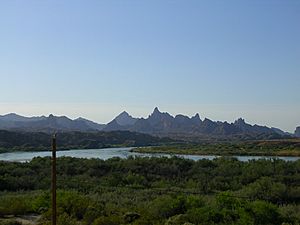
The Colorado River and its branches often support wide areas of riparian growth (plants along riverbanks) as they flow through the dry desert. Even though these areas are a small part of the basin and have been changed by dams and diversions, they have the most different types of living things. The most important riparian areas along the river are below Davis Dam, especially in the Colorado River Delta. These areas support 358 species of birds, even with less freshwater and invasive plants like tamarisk. The shrinking of the delta has also threatened animals like jaguars and the vaquita porpoise, which only live in the gulf. Human development of the Colorado River has also helped create new riparian zones by making the river's seasonal flow smoother, especially through the Grand Canyon.
More than 1,600 species of plants grow in the Colorado River watershed. These range from creosote bushes and saguaro cactuses in the Sonoran and Mojave Deserts to forests of ponderosa pine and Douglas-fir in the Rocky Mountains. Before logging in the 1800s, forests were common in high elevations. Water from these areas fed many grasslands in river valleys. Some dry regions, like the upper Green River valley, had large grasslands where animals like buffalo and antelope roamed as late as the 1860s.
Rivers and streams in the Colorado basin used to have 49 species of native fish. 42 of these were endemic, meaning they lived nowhere else. Dams and river control have caused four species to become extinct and 40 species to decline severely. Bonytail chub, razorback sucker, Colorado pikeminnow, and humpback chub are among those most at risk. They are unique to the Colorado River system and were well-suited to the river's natural muddy conditions and changing flows. Clear, cold water released by dams has greatly changed the habitat for these fish. Another 40 species of fish, like the brown trout, were brought into the river in the 1800s and 1900s, mainly for sport fishing.
Impacts of Human Development on the River
Historically, the Colorado River carried 85 to 100 million short tons (77,000,000 to 91,000,000 t) of sediment or silt to the Gulf of California each year. This was second only to the Mississippi River in North America. This sediment fed wetlands and riverside areas along the lower river, especially in its 3,000-square-mile (7,800 km2) delta. Today, most of the sediment carried by the Colorado River settles at the upper end of Lake Powell. Most of the rest ends up in Lake Mead. Scientists estimate it would take 300 to 700 years for Lake Powell to completely fill with silt. Dams trapping sediment not only harm river habitats but also threaten the future use of the Colorado River's reservoir system.
Less water flow caused by dams, diversions, and evaporation from reservoirs has had serious environmental effects in the Colorado River Delta and the Gulf of California. Evaporation alone uses more than 15 percent of the river's natural flow. Historically, the delta, with its large freshwater flow and salt marshes, was an important breeding ground for sea animals in the Gulf. Today's dry delta is much smaller and no longer provides good habitat. Populations of fish, shrimp, and sea mammals in the gulf have greatly decreased. Since 1963, the Colorado River has only reached the ocean during El Niño events in the 1980s and 1990s.
Reduced flows have also increased the amount of certain substances in the lower river, affecting water quality. Saltiness (salinity) is a major problem. It also causes pipes in farming and city areas to rust. The lower Colorado's salt content was about 50 parts per million (ppm) naturally. But by the 1960s, it had increased to over 2000 ppm. By the early 1970s, there was also serious concern about salt from irrigation drainage water. This was estimated to add 10 million short tons (9,100,000 t) of extra salt to the river each year. The Colorado River Basin Salinity Control Act was passed in 1974. It required efforts to reduce salty drainage. The program reduced the annual salt load by about 1.2 million short tons (1,100,000 t), but saltiness is still an issue. In 1997, the USBR estimated that salty irrigation water caused over $500 million in crop damage in the U.S. and $100 million in Mexico. More efforts have been made to fight the salt problem, including building a desalination plant at Yuma. In 2011, the seven U.S. states agreed to a "Plan of Implementation." This plan aims to reduce saltiness by 644,000 short tons (584,000 t) per year by 2030. In 2013, the Bureau of Reclamation estimated that about $32 million was spent each year to prevent about 1.2 million tons of salt from entering the Colorado River.
Farm runoff with pesticide residues has also become more concentrated in the lower river. This has led to fish dying. Six such events were recorded between 1964 and 1968 alone. The pesticide problem is even worse in streams and water bodies near farms irrigated by the Imperial Irrigation District. In the Imperial Valley, Colorado River water used for irrigation flows into the New and Alamo rivers and into the Salton Sea. Both rivers and the sea are among the most polluted bodies of water in the United States. This poses dangers to aquatic life, humans, and migrating birds. Pollution from farm runoff is not only in the lower river. It is also a problem in upstream areas like Colorado's Grand Valley, which is also a major farming center.
Large dams like Hoover and Glen Canyon usually release water from the lower parts of their reservoirs. This results in stable and relatively cold temperatures year-round in long parts of the river. The Colorado's average temperature used to range from 85 °F (29 °C) in summer to near freezing in winter. But modern flows through the Grand Canyon, for example, rarely change much from 46 °F (8 °C). These temperature changes have caused native fish populations to decline. Stable flows have also allowed more plants to grow, blocking riverside habitats. These flow patterns have also made the Colorado more dangerous for recreational boaters. People are more likely to get hypothermia in the colder water. And the lack of floods allows rockslides to build up, making the river harder to navigate.
Bringing Water Back to the Delta
In the 2000s, there has been new interest in bringing a limited water flow back to the delta. In November 2012, the U.S. and Mexico made an agreement called Minute 319. This allows Mexico to store its water share in U.S. reservoirs during wet years. This makes water use more efficient. Besides fixing irrigation canals in the Mexicali Valley to reduce leaks, this will make about 45,000 acre-feet (56,000,000 m3) per year available for release to the delta on average. The water will provide both a yearly base flow and a spring "pulse flow." This pulse flow will copy the river's original snowmelt-driven floods. The first pulse flow, an eight-week release of 105,000 acre-feet (130,000,000 m3), started on March 21, 2014. Its goal was to bring life back to 2,350 acres (950 hectares) of wetland. This pulse reached the sea on May 16, 2014. This was the first time in 16 years that any water from the Colorado flowed into the ocean. It was called "an experiment of historic political and ecological significance" and a major step in U.S.–Mexican cooperation for conservation.
Recreation: Fun on the Colorado River
Famous for its exciting rapids and canyons, the Colorado is one of the most popular whitewater rivers in the United States. Its Grand Canyon section is run by over 22,000 people every year. It has been called the "granddaddy of rafting trips." Grand Canyon trips usually start at Lee's Ferry and end at Diamond Creek or Lake Mead. They can last from one to eighteen days for commercial trips, and two to twenty-five days for private trips. Private trips are very hard to arrange because the National Park Service limits river traffic to protect the environment. People who want such a trip often have to wait more than 10 years.
Several other parts of the river and its branches are popular for whitewater rafting. Many of these also have commercial tour companies. The Colorado's Cataract Canyon and many areas in the Colorado headwaters are used even more than the Grand Canyon. About 60,000 boaters use a single 4.5-mile (7.2 km) section above Radium, Colorado, each year. The upper Colorado also has many of the river's most challenging rapids, including those in Gore Canyon. This canyon is considered so dangerous that "boating is not recommended." Another section of the river above Moab, called the Colorado "Daily" or "Fisher Towers Section," is the most visited whitewater run in Utah. It had over 77,000 visitors in 2011 alone. The rapids of the Green River's Gray and Desolation Canyons, and the easier "Goosenecks" section of the lower San Juan River, are also often used by boaters.
Eleven U.S. national parks are in the watershed: Arches, Black Canyon of the Gunnison, Bryce Canyon, Canyonlands, Capitol Reef, Grand Canyon, Mesa Verde, Petrified Forest, Rocky Mountain, Saguaro, and Zion. There are also many national forests, state parks, and recreation areas. Hiking, backpacking, camping, skiing, and fishing are some of the many fun activities offered in these areas. Fishing has declined in many streams, especially in the Rocky Mountains. This is due to polluted water from mining and farming.
The Colorado's major reservoirs are also popular summer destinations. Houseboating and water-skiing are common activities on Lakes Mead, Powell, Havasu, and Mojave. They are also popular on Flaming Gorge Reservoir in Utah and Wyoming, and Navajo Reservoir in New Mexico and Colorado. Lake Powell and the surrounding Glen Canyon National Recreation Area had over two million visitors per year in 2007. Nearly 7.9 million people visited Lake Mead and the Lake Mead National Recreation Area in 2008. Recreation on the Colorado River provides jobs for about 250,000 people. It adds $26 billion each year to the Southwest economy.
Images for kids
-
The San Juan River near Mexican Hat, Utah
See also
 In Spanish: Río Colorado para niños
In Spanish: Río Colorado para niños



